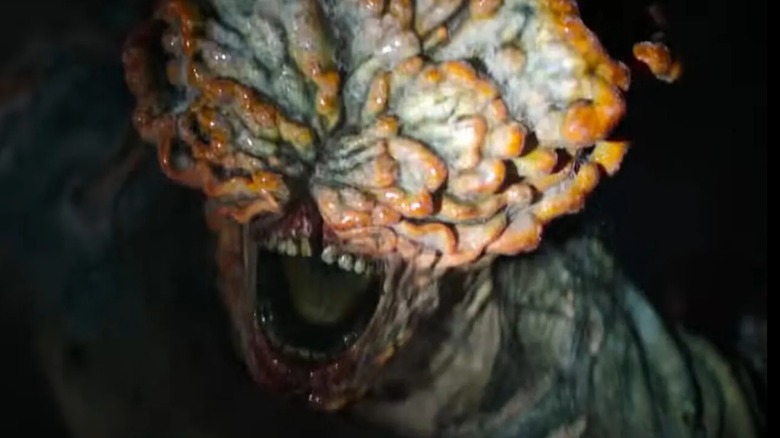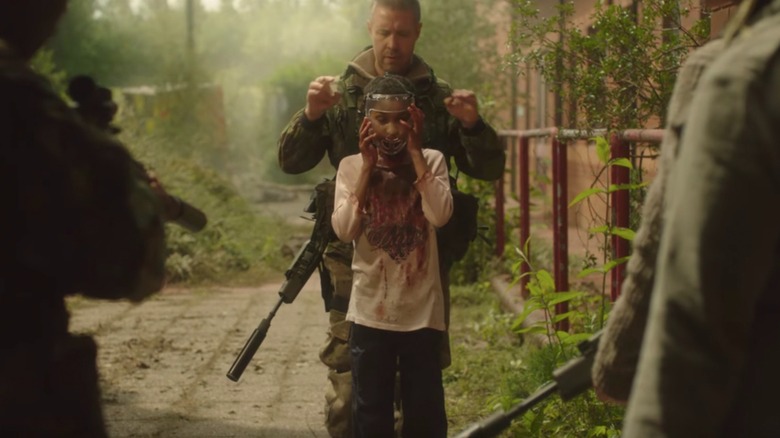Before The Last Of Us, Another Story Explored A Fungal Zombie Apocalypse
We may receive a commission on purchases made from links.
What most sets "The Last of Us" apart from other zombie apocalypse stories is the zombies' oirigin. The "clickers" or "infected" are not shambling, undead corpses. Rather, the infection comes from the Cordyceps fungus, a real parasite which can infect ants and take over their bodies. In "The Last of Us," the fungus starts to infect humans.
The Cordyceps zombies are covered in fungal growths, with long-infected ones having heads that look like mushrooms. This makes "The Last of Us" infected even creepier than typical zombies. A virus that brings the dead back to life is almost assuredly pure science fiction. Since Cordyceps fungi are real, though, this apocalypse feels more plausible. The popularity of the original "The Last of Us" games and HBO show has also increased cultural awareness of the Cordyceps. New hit horror movie "Weapons" uses Cordyceps as a metaphor for the central villain.
But is "The Last of Us" really the story that invented fungus zombies? In 2012, a year before "The Last of Us" first released, writer Mike "M. R." Carey published a short story, "Iphigenia in Aulis," about a world overrun by Cordyceps zombies. Carey turned the story into a full novel, "The Girl with All The Gifts," published in 2014, which was then adapted into a movie in 2016.
That the stories came out so close together, and had such similar premises, is a coincidence that might raise eyebrows. While "Iphigenia in Aulis" released first, "The Last of Us" had been in development since 2009 and had a trailer out by December 2011. For what it's worth, Carey claimed in a Goodreads Q&A that he had never heard of "The Last of Us" until he finished writing "The Girl with All the Gifts."
In fact, it appears that both stories were inspired by the same source material. Carey has said he learned about Cordyceps from a David Attenborough nature documentary. This was likely the 2006 BBC series "Planet Earth," narrated by Attenborough, which "The Last of Us" creator Neil Druckmann also cited as his source. I can understand two different writers coming up with the same idea upon learning about Cordyceps. As Carey noted, Cordyceps sounds too fantastic and scary to be real. Its existence inevitably makes you think, "Thank God it doesn't infect humans," and from there any creative mind will ask, "Except, what if..."
So, with how similar the stories and settings are, is there anything that sets them apart?
The Girl with All the Gifts ends like few zombie stories have
Both "The Last of Us" and "The Girl with All the Gifts" center on a young girl with a crucial genetic destiny. In "The Last of Us," that's Ellie (Ashley Johnson in the games, Bella Ramsey in the show), who is naturally immune to the fungus infection. In Carey's story, the titular "Girl with All the Gifts" is Melanie (played in the movie by Sennia Nanua). Melanie is infected but she retains higher brain functions and a human personality, unlike the usual "Hungries." Both Melanie and Ellie are targeted by scientists trying to make a vaccine.
"The Girl with All the Gifts" ends much differently than "The Last of Us." Melanie isn't immune because of a mutation but because she's a second generation Hungry. The infected parents pass the fungus onto their children, but their children are born with some natural immunity. They're not completely human, but they're not mindless and feral like people who were infected later in life either. Since there's no way to make a vaccine, the only option is to let the plague run its course until everyone is infected, then build a new civilization from there.
The story ends with Melanie unleashing the infectious spores across the world. The title "The Girl with All the Gifts" refers to the Greek myth of Pandora (which is alluded to in the book and movie). Pandora was the first human woman who opened a box full of evil that infected mankind. This ending is, of course, Melanie opening Pandora's Box, unleashing a different kind of infection on humanity. In the final scene, Melanie and her teacher Ms. Justineau (Gemma Arterton) work together to teach the infected children how to be human. It's a hopeful ending, but one that cuts off any chance of the pre-apocalypse world returning.
In addition to his prose novels, Carey is a prolific comic book writer. His story's theme of human evolution, and a new generation of mutants inheriting the Earth, takes on a new light when you know he once penned an underrated run on "X-Men."
Carey's latest (and excellent) book, "Once Was Willem," is another kind of zombie story, too. In 12th century England, a poor village family makes a bargain with a wizard to bring their dead son, Willem, back to life. But the resulting revenant is only an uncanny facsimile, and clearly inhuman in appearance — hence his adopted name, Once Was Willem. Essentially a medieval, folk-horror "Frankenstein," "Once Was Willem" is an essential read for any Carey fans, just like "The Girl with All the Gifts" will excite any "The Last of Us" lovers.

